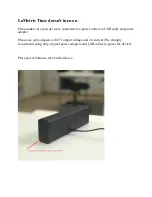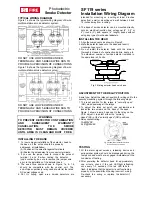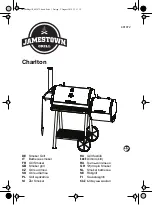
2 / 8
P/N 1036525-EN • REV F
Compatibility
Please refer to the
ESL Compatibility Index
for a complete
listing of control panels and proper identifiers. For a copy of the
compatibility index, see “Contact information” on page 8.
Remember, four-wire smoke detectors do not require a
compatibility listing.
Selecting a location
Selecting a suitable location is critical to the operation of
smoke detectors. This equipment should be installed in
accordance with NFPA 72. Figure 1 shows required and
additional locations.
Figure 1: Detector location
(1) Dining
Room
(2) Kitchen
(3) Living
Room
(4)
Bedroom
(5) TV
Room
(6) Basement
Required
smoke
detectors
Additional alarms required for new construction
Where to locate the required smoke detectors in existing
construction.
The major threat from fire in a family living unit
occurs at night when everyone is asleep. The principal threat
to persons in sleeping areas comes from fires in the remainder
of the unit. Therefore, a smoke detector is best located
between the bedroom areas and the rest of the unit. In units
with only one bedroom area on one floor, the smoke detector
should be located as shown in Figure 1-A.
In family living units with more than one bedroom area or with
more than one floor, more than one smoke detector is
required, as shown in Figure 1-B.
In addition to smoke detectors outside of the sleeping areas,
the installation of a smoke detector on each additional story of
the family living unit, including the basement, is required.
These installations are shown in Figure 1-C. The living area
smoke detector should be installed in the living room or near
the stairway to the upper level, or in both locations. The
basement smoke detector should be installed in close
proximity to the stairway leading to the floor above. Where
installed on an open-joisted ceiling, the alarm should be placed
on the bottom of the joists. The alarm should be positioned
relative to the stairway to intercept smoke coming from a fire in
the basement before the smoke enters the stairway.
Where to locate the required smoke detectors in new
construction.
All of the smoke detectors specified for existing
construction are required and, in addition, a smoke detector is
required in each bedroom.
Are more smoke detectors desirable?
The required number
of smoke detectors might not provide reliable early warning
protection for those areas separated by a door from the areas
protected by the required smoke detectors. For this reason, it
is recommended that the householder consider the use of
additional smoke detectors for those areas for increased
protection. The additional areas include the basement,
bedrooms, dining room, furnace room, utility room, and
hallways not protected by the required smoke detectors. The
installation of smoke detectors in kitchens, attics (finished or
unfinished), or garages is not normally recommended, as these
locations occasionally experience conditions that can result in
improper operation.
Note:
Regulations pertaining to smoke detector installation
vary from state to state. For more information, contact your
local fire department or local authority having jurisdiction.
Additional considerations.
In addition to NFPA 72, use the
following location guidelines to optimize performance and
reduce the chance of false alarms from the detector:
•
Locate ceiling-mounted smoke detectors in the center of a
room or hallway at least 4 in. (10 cm) from any walls or
partitions.
•
Locate wall-mounted smoke detectors so the top of the
alarm is 4 to 12 in. (10 to 31 cm) below the ceiling.
•
Do not
locate detectors in or near bathrooms or kitchens.
•
Locate smoke alarms in a suitable environment with
temperature and humidity as defined in “Specifications” on
page 8.
•
Locate smoke detectors away from air conditioners,
heating registers, and any other ventilation source that
may interfere with smoke entering the alarm.
•
Mount smoke detectors on a firm, permanent surface.
Installing the detector
All wiring must conform to the National Electric Code (NEC)
and/or local codes having jurisdiction. Use 12 to 24 AWG (16
to 22 AWG recommended) wire to install the detector.
1. If you are using the detector-base lock, remove the
detector knockout and break off the tab on the mounting
base. See Figure 2.
2. Remove the red plastic cover from the detector. The
detector is shipped with a cover for protection against
construction site dust.
(1)
(2)
(3)
(4)
(4)
(4)
(1)
(2)
(3)
(4)
(5)
(4)
(4)
(4)
(4)
(3)
(1)
(6)
A
B
C


























